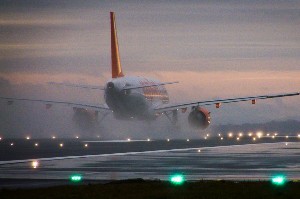 Research conducted at University of Lincoln in the U.K. indicates airliners can power their taxiing after landing by harnessing energy in the wheel rotation of their landing gear to generate electricity. The study was funded by a grant from the Engineering and Physical Sciences Research Council (EPSRC), the U.K. government’s main funding agency for studies in engineering and the physical sciences.
Research conducted at University of Lincoln in the U.K. indicates airliners can power their taxiing after landing by harnessing energy in the wheel rotation of their landing gear to generate electricity. The study was funded by a grant from the Engineering and Physical Sciences Research Council (EPSRC), the U.K. government’s main funding agency for studies in engineering and the physical sciences.
The research, led by Lincoln’s engineering professor Paul Stewart, investigated many ideas proposed for capturing energy generated by aircraft when landing. One of the few ideas in the inquiry found technically feasible and cost-effective involved the capture of energy from an aircraft after touching down. “When an Airbus 320 lands,” says Stewart, “a combination of its weight and speed gives it around three megawatts peak available power.”
The energy produced by a plane’s braking system during landing is currently wasted as heat produced by friction in the aircraft’s disc brakes. Stewart’s study recommends capturing and converting that energy into electricity with generators built into the landing gear. The electricity would then be stored and supplied to the in-hub motors in the wheels of the plane when it needed to taxi. The aircraft’s conventional engines could still supplement the captured electric power if required.
“Taxiing is a highly fuel-inefficient part of any trip by plane with emissions and noise pollution caused by jet engines being a huge issue for airports all over the world,” says Stewart. “Currently, commercial aircraft spend a lot of time on the ground with their noisy jet engines running,” Stewart adds. “In the future this technology could significantly reduce the need to do that.”
Some technical issues still remain, however. Any system for on-board energy recovery, for example, would need to minimize additional weight added to the aircraft from added conductors and electronic power converters.
The 12-month “Feasibility Study of Energy Recovery from Landing Aircraft” received total EPSRC funding of £161,000 ($US 252,000). The project was carried out under the EPSRC-funded Airport Energy Technologies Network begun in 2008 to conduct low-carbon research in the field of aviation.
Read more:
- Grant to Fund New Program Logic for Flight Data Integration
- System Being Developed to Watch for Airport Runway Debris
Photo: ChronowerX_GT/Flickr
* * *

 RSS - Posts
RSS - Posts
You must be logged in to post a comment.